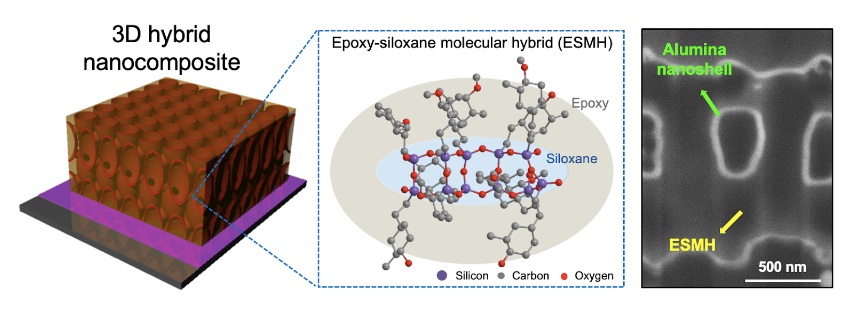Prof. S. Jeon, B.-S. Bae, S.M. Han, and J.-W. Hong’s groups have developed an unconventional 3D nanocomposite film that is ultrahard, yet flexible, and applicable to flexible protective films. The research was published online on February 25 in Advanced Functional Materials (DOI: 10.1002/adfm.202010254).
Recently, flexible optoelectronics require a nontrivial protective film that is hard, yet flexible. Organic-inorganic (O-I) hybrid materials have been widely used as flexible cover windows for flexible devices due to their high wear resistance and polymer-like flexibility. However, the hardness of O-I hybrid materials is still lower than that of other materials, such as metals or ceramics.
To solve the issue, the research team adopted “3D inorganic nanostructure” as an additional reinforcement of the O-I hybrid materials. The 3D alumina nanoshell, evenly distributed in the epoxy-siloxane molecular hybrid (ESMH), significantly enhances the hardness and damage tolerance of the nanocomposite, while maintaining polymer-like flexibility and transparency.
The 3D hybrid nanocomposite film showed metal-like hardness (~1.3 GPa), much higher than that of the conventional polymer nanocomposites. In addition, the inch-scale hybrid nanocomposite films achieve superior optical transparency in the visible light range (85.1 % transmittance at 550 nm wavelength), and the transparency is nearly maintained even after 20,000 dynamic bending cycles (>82.0 % at 550 nm).
Professor Jeon said, “the significance of the developed 3D nanocomposite system embedding 3D nanostructure is that it can easily change the base material used by reinforcement and matrix suitable for specific applications.” Thus, the 3D nanoshell structure composed of various functional materials can be widely adapted to other applications, including energy conversion and storage devices or sensors.
“Developed 3D nanocomposite is expected to provide a good perspective for a next-generation protective film applicable to flexible and foldable devices,” said first author Gwangmin Bae, a graduate student in the Department of Materials Science and Engineering at KAIST.
This work was supported, in part, by the Creative Materials Discovery Program and Multi-Ministry Collaborative R&D Program.

Mr. Gwangmin Bae, Prof. Seokwoo Jeon, Prof. Byeong-Soo Bae,
Prof. Seung Min Han, Prof. Jung-Wuk Hong
Dept. of Materials Science and Engineering, KAIST
Homepage: https://fdml.kaist.ac.kr
E-mail: jeon39@kaist.ac.kr






